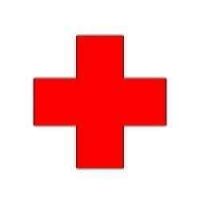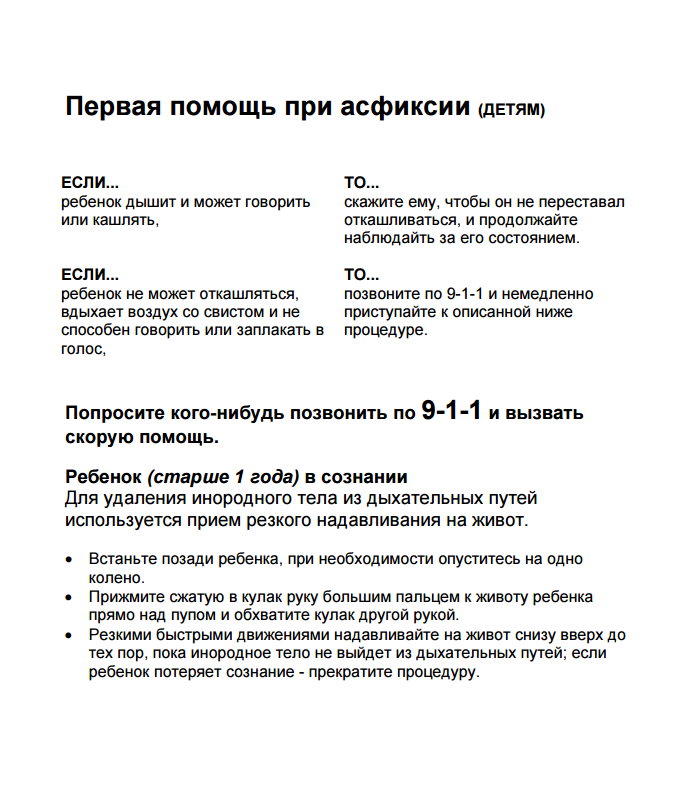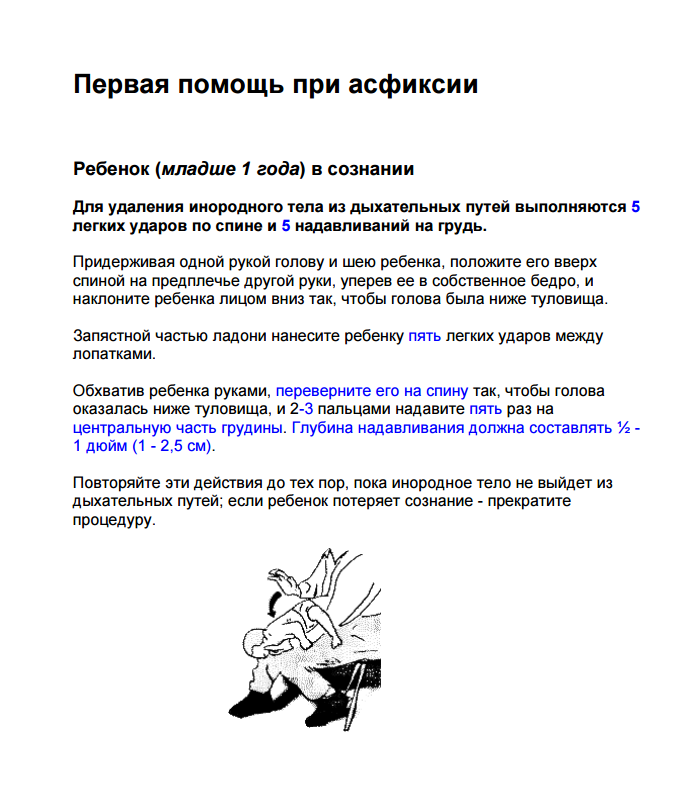Emergency help with asphyxia

In Europe, first aid in case of asphyxia is taught since childhood.
It's also often ironic - remember, in several comedies such as "The Scariest Movie" there are such scenes.
BUT .... all this would be ridiculous, if it were not so sad, and would not concern people who were dear to you, or even simply by the will of fate who were close to you in the fateful moment for them.
Instruction, where it is popularly described how to act when asphyxiated in the case of an adult and a child.
Asphyxia is a difficulty in breathing, causing a shortage of oxygen and an excess of carbon dioxide in the blood and tissues of the body. Suffocation is accompanied by cyanotic skin, for example, by squeezing the airways from the outside (strangulation), closing their lumen with edema, etc. The asthma attack usually occurs at night; In the afternoon - less often.
There are 2 types of asphyxiation:
- I. Non-violent (bronchial, cardiac asthma, allergic edema of the larynx, etc.)
- II. Violent (divided into subspecies ):
- Suffocation from the closure (closing) of the airways or openings (drowning, ingress of foreign bodies into the respiratory tract);
- Suffocation from squeezing the neck (hanging, looping, hand-wiping);
- Suffocation from squeezing the chest and abdomen with heavy or loose objects, as well as in a crush, in a crowd.
Symptoms and signs of suffocation (asphyxia):
- Asthmatic attack: the patient tends to take a vertical position with a forward tilt; Breathes noisily, inhales and exhales with a "whistle," wheezes; At the end of the attack, separation of viscous sputum with mucus may be observed;
- Attack of cardiac asthma: the patient also sits or stands, leaning forward, often and hard breathing; Separation of sputum does not occur;
- With an allergic swelling of the larynx, the patient grasps at the throat, often can not breathe, the face turns purple;
- Symptoms and signs of violent suffocation are usually visible to the naked eye: traces on the neck, in the mouth or nose area, broken ribs.
What to do with asphyxiation:
- When a bronchial asthma attack occurs, the patient should be seated (if he is not able to do it himself), provide fresh air, place his feet in a container with hot water (on the ankles), or use warmers, put mustard plasters on the chest and back Below the scapula, give to take eufillin (according to instructions) or, if you know how, make a subcutaneous injection of aralinine (0.2-0.5 ml of 0.1% solution);
- If you have an allergic swelling of the larynx, you should immediately call a doctor, and before that, take an antihistamine drug (dimedrol, suprastin, tavegil - including injection, drink 1/4 of the solution of chloride or calcium gluconate) in severe cases intramuscularly inject 2 ml. Prednisolone;
- If the choking is caused by the foreign body entering the larynx, try to pull it out. If the foreign body is not visible, or is already in the airway, you need to tilt the patient forward, jerkily pushing your hands along the bottom line of the ribs, so that the air that remained in the lungs pushes the foreign body out. After successful extraction, you must always see a doctor so that he can examine the patient and prescribe a course of antibiotics to prevent the development of inflammatory processes in the lungs.
- With forced strangulation, the body of the victim should be released as soon as possible from objects that do not allow him to breathe, call a doctor, give a drink (if you are sure that the ribs are intact, the lungs are not damaged - that is, suffocation only touched the neck).
What NOT to do with asphyxiation:
- Do not idle;
- Do not drink if there is a suspicion of lung damage;
How to say "choking" and "asphyxiation" in a foreign language:
- In English: asthma (asthma), asphyxia - asphyxia (esfixia)
- In German: choking - erstickung (erstikung)
- In French: choking - etouffement (thisfeman), asphyxia - asphyxie (asphyxia)
- In Spanish: asphyxia, asphyxia - asfixia (asphyxia)
Assistance with mechanical asphyxia
- In the case when asphyxia is caused by squeezing the chest with heavy objects or tight clothes, you need to get rid of them and release the thorax.
- Immediately need to call an ambulance, ensure free air flow to the victim.
- Lay the victim on his side, to avoid spasms, vomiting, which can cause lung edema, stop the breathing of the circulation. There may be a clinical death.
- If strangulation occurs from a foreign object (food, vomit), you should try to remove it from your throat with your fingers.
- In the case where a simple cough does not help, you need to bend the victim through the knee, a piece of furniture or just tilt the body of his body forward and hit two or three times on the back.
- If from suffocation suffers a small child (up to three years), then it is necessary to take both hands by his legs in the position with his head down and with cautious shaking movements to release the airways.
- Effective in asphyxiation is the method of Heimlich: a sharp strong squeezing of the patient's diaphragm in a position from behind, clutching him with two locked in the lock hands in front.
First aid to the victim in the unconscious state
- If the victim has lost his breath, it should be prevented from suffocating from tongue twisting. For this it is necessary to put the person on the back and to throw his head back as far as possible. Then you need to lower, gently push the lower jaw forward, hold the tongue with your fingers using a piece of tissue (handkerchief, gauze) and somehow attach it to the lower jaw, for example, using a pin. To prevent swelling of the larynx tissues, you need to attach ice to the neck area. Cooling will help to avoid exacerbating the situation.
- When first aid is given in asphyxiation, every 1 to 2 minutes, it is necessary to check the presence of pulse and respiration. If they are not present, artificial ventilation should be started. In case of cardiac arrest, you need to perform an indirect cardiac massage.
- If you have witnessed the symptoms of suffocation in a person (shortness of breath, wheezing, disorderly gestures, convulsions), first aid for asphyxiation should be immediate. You need to act independently, not expecting the arrival of an ambulance. Strangulation leads to death in a matter of minutes.




 Emergency help with asphyxiation (instruction, pdf)
Emergency help with asphyxiation (instruction, pdf)



Comments
When commenting on, remember that the content and tone of your message can hurt the feelings of real people, show respect and tolerance to your interlocutors even if you do not share their opinion, your behavior in the conditions of freedom of expression and anonymity provided by the Internet, changes Not only virtual, but also the real world. All comments are hidden from the index, spam is controlled.